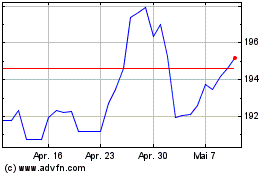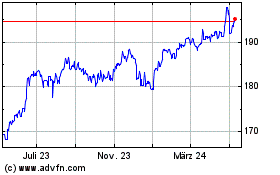Pound Slides After U.K. GDP Data
29 September 2017 - 9:15AM
RTTF2
The British pound weakened against other major currencies in the
Asian session on Friday, after data showed that the U.K. economic
growth expanded at a slower pace year-on-year in the second
quarter, than previously estimated.
Data from the Office for National Statistics showed that
Britain's economy grew 1.5 per cent in the three months ending in
June from the same period in 2016. It was the weakest level since
the first quarter of 2013. Economists had forecast the GDP to
remain unchanged from a previous estimate at 1.7 percent.
The U.K. economy grew as previously estimated in the second
quarter. Nonetheless, past data on the national accounts and
balance of payments were revised.
Gross domestic product grew 0.3 percent sequentially in the
second quarter, unrevised from the second estimate published on
August 24, and the same rate as seen in the first quarter.
The first quarter growth was revised up from 0.2 percent.
In an another report, ONS said the current account deficit
widened to GBP 23.2 billion from GBP 22.3 billion in the first
quarter.
Also, data from the Bank of England showed that U.K. mortgage
approvals declined in August. The number of mortgage approvals fell
more-than-expected to 66,580 in August from 68,452 in the previous
month. The expected level was 67,300.
In other economic news, data from the Nationwide Building
Society showed that U.K. house prices increased at a slower pace in
September. London became the weakest performing region for first
time since 2005, with house prices down 0.6 percent
year-on-year.
On a national level, house prices grew 2 percent in September
from the previous year, following August's 2.1 percent increase.
Economists had forecast a marginal 0.1 percent increase.
On a monthly basis, house prices gained 0.2 percent, in contrast
to a 0.1 percent fall in August.
In the Asian trading today, the pound held steady against its
major rivals.
In the European trading, the pound fell to a 3-day low of 150.20
against the yen, from an early high of 151.28. The pound may test
support near the 147.00 region.
Against the euro and the Swiss franc, the pound dropped to 4-day
lows of 0.8836 and 1.2968 from early highs of 0.8763 and 1.3042,
respectively. If the pound extends its downtrend, it is likely to
find support around 0.89 against the euro and 1.27 against the
franc.
The pound edged down to 1.3354 against the U.S. dollar, from an
early high of 1.3443. On the downside, 1.31 is seen as the next
support level for the pound.
Looking ahead, Canada GDP data for July and industrial product
price index for August, as well as U.S. personal income and
spending data for August and University of Michigan's final
consumer sentiment for September are due in the New York
session.
At 8:00 am ET, the Bank of England Deputy Governor Jon Cunliffe
will speak at the Single Resolution Board Conference at
Brussels.
At 8:30 am ET, BOE Deputy Governor Ben Broadbent participate in
a panel discussion titled "The future of central bank independence"
at the Bank of England's conference celebrating 20 years of
independence, in London
At 11:00 am ET, Federal Reserve Bank of Philadelphia President
Patrick Harker speaks about the economic outlook and financial
technology at the Fintech conference hosted by the Federal Reserve
Bank of Philadelphia.
Sterling vs Yen (FX:GBPJPY)
Forex Chart
Von Mär 2024 bis Apr 2024

Sterling vs Yen (FX:GBPJPY)
Forex Chart
Von Apr 2023 bis Apr 2024
